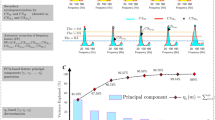Abstract
The basic parameters of the spectrogram, the Choi-Williams, and the Bessel distributions are adjusted to provide the best time-frequency representations (TFRs) of the simulated murmur signals of mitral stenosis, mitral regurgitation, aortic stenosis, aortic regurgitation, and of two musical murmurs. The initial adjustment of the parameters of each TFR technique is performed by computing and minimising the relative averaged absolute error between the frequency contours at −3dB and −10dB of each TFR of the simulated murmurs and those of the theoretical distribution of the same signals. The results show that the spectrogram generally provides very good to excellent performance in representing the TFRs of stenotic and regurgitant murmurs. Improvements provided by the Choi-Williams and the Bessel distributions are minor but not systematic for the two signal-to-noise ratios tested (0 and 30 dB) and for the two frequency contours estimated. The Bessel and the Choi-Williams distributions provide the best performance for the musical murmurs. The study shows that although a single technique cannot be optimal for all six murmurs, the spectrogram using a Hamming window of 30 ms is an acceptable compromise to detect the six simutated heart murmurs.
Similar content being viewed by others
References
Baraniuk, R. G., andJones, D. L. (1993): ‘A signal-dependent time-frequency representation: optimal kernel design’,IEEE Trans. Signal Process.,41, pp. 1589–1602
Cohen, L. (1989): ‘Time-frequency distributions—a review’,Proc. IEEE,77, pp. 941–981
Chen, D., Durand, L.-G., andLee, H. C. (1997a): ‘Time-frequency analysis of the first heart sound. Part I: Simulation and analysis’,Med. Biol. Eng. Comput.,35, pp. 306–310
Chen, D., Durand, L.-G., Guo, Z., andLee, H. C. (1997b): ‘Time-frequency analysis of the first heart sound. Part 2: An appropriate time-frequency representation technique’,Med. Biol. Eng. Comput.,35, pp. 311–317
Chen, D., Durand, L.-G., Lee, H. C., andWieting, D. W. (1997c): ‘Time-frequency analysis of the first heart sound. Part 3: Application to dogs with varying cardiac contractility and to patients with mitral mechanical prosthetic heart valves’,Med. Biol. Eng. Comput.,35, pp. 455–461
Debiais, F., Durand, L.-G., Pibarot, P., andGuardo, R. (1997): ‘Time-frequency analysis of heart murmurs. Part I: Parametric modelling and numerical simulations’,Med. Biol. Eng. Comput.,35, pp. 474–479
Donnerstein, R. L. (1992): Quantitative assessment of stenotic heart lesions by continuous spectral analysis of heart murmurs.’ Proceedings of the 14th Annual International Conference of the IEEE Engineering Medicine and Biology Society, pp. 2586–2587
Durand, L. G., andPibarot, P. (1995): ‘Digital signal processing of the phonocardiogram: review of the most recent advancements’,CRC Crit. Rev. Biomed. Eng.,23, pp. 163–219
Guo, Z., Durand, L. G., andLee, H. C. (1994a): ‘The time-frequency distributions of nonstationary signals based on a Bessel Kernel’,IEEE Trans. Signal Process.,42, pp. 1700–1707
Guo, Z., Durand, L. G., andLee, H. C. (1994b): ‘Comparison of time-frequency distribution techniques on simulated Doppler ultrasound signal of the femoral artery’,IEEE Trans. Biomed. Eng.,41, pp. 332–341
Hlawatsch, F., andKozek, W. (1993): ‘The Wigner distribution of a linear signal space’,IEEE Trans. Signal Process.,41, pp. 1248–1258
Nygaard, H., Thuesen, L., Hasenkam, J. M., andPedersen, E. M. (1993): ‘Assessing the severity of aortic valve stenosis by spectral analysis of cardiac murmurs (spectral vibrocardiography). Part I: Technical aspects’,J. Heart Valve Dis.,2, pp. 454–467
Papandreaou, A., andBoudreaux-Bartels, G. F. (1993): ‘Generalization of the Choi-Williams distribution and the Butterworth distribution for time-frequency analysis’,IEEE Trans. Signal Process.,41, pp. 463–472
Portnoff, M. R. (1980): ‘Time-frequency represenatation of digital signals and systems based on short-time Fourier analysis’,IEEE Trans. Acoust. Speech. Signal Process.,28, pp. 55–68
Tavel, M. E. (1996): ‘Cardiac auscultation. A glorius part—but does it have a future?,Circulation,93, pp. 1250–1253
Author information
Authors and Affiliations
Corresponding author
Rights and permissions
About this article
Cite this article
Debiais, F., Durand, L.G., Guo, Z. et al. Time-frequency analysis of heart murmurs. Part II: Optimisation of time-frequency representations and performance evaluation. Med. Biol. Eng. Comput. 35, 480–485 (1997). https://doi.org/10.1007/BF02525527
Received:
Accepted:
Issue Date:
DOI: https://doi.org/10.1007/BF02525527




